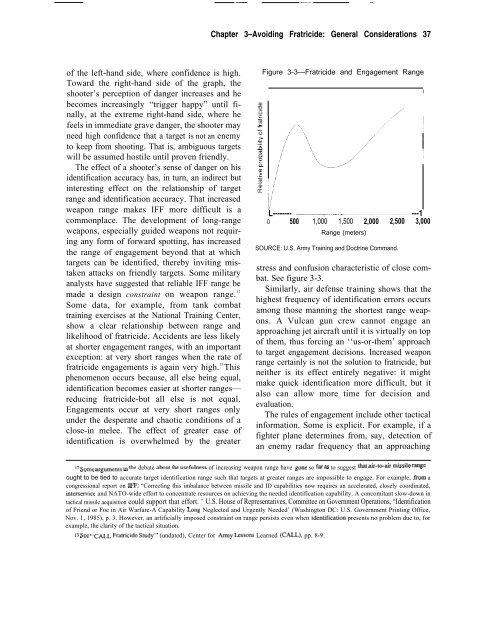Who Goes There: Friend or Foe? - Federation of American Scientists
Who Goes There: Friend or Foe? - Federation of American Scientists
Who Goes There: Friend or Foe? - Federation of American Scientists
You also want an ePaper? Increase the reach of your titles
YUMPU automatically turns print PDFs into web optimized ePapers that Google loves.
<strong>of</strong> the left-hand side, where confidence is high.<br />
Toward the right-hand side <strong>of</strong> the graph, the<br />
shooter’s perception <strong>of</strong> danger increases and he<br />
becomes increasingly “trigger happy” until finally,<br />
at the extreme right-hand side, where he<br />
feels in immediate grave danger, the shooter may<br />
need high confidence that a target is not an enemy<br />
to keep from shooting. That is, ambiguous targets<br />
will be assumed hostile until proven friendly.<br />
The effect <strong>of</strong> a shooter’s sense <strong>of</strong> danger on his<br />
identification accuracy has, in turn, an indirect but<br />
interesting effect on the relationship <strong>of</strong> target<br />
range and identification accuracy. That increased<br />
weapon range makes IFF m<strong>or</strong>e difficult is a<br />
commonplace. The development <strong>of</strong> long-range<br />
weapons, especially guided weapons not requiring<br />
any f<strong>or</strong>m <strong>of</strong> f<strong>or</strong>ward spotting, has increased<br />
the range <strong>of</strong> engagement beyond that at which<br />
targets can be identified, thereby inviting mistaken<br />
attacks on friendly targets. Some military<br />
analysts have suggested that reliable IFF range be<br />
made a design constraint on weapon range. 12<br />
Some data, f<strong>or</strong> example, from tank combat<br />
training exercises at the National Training Center,<br />
show a clear relationship between range and<br />
likelihood <strong>of</strong> fratricide. Accidents are less likely<br />
at sh<strong>or</strong>ter engagement ranges, with an imp<strong>or</strong>tant<br />
exception: at very sh<strong>or</strong>t ranges when the rate <strong>of</strong><br />
fratricide engagements is again very high. 13<br />
This<br />
phenomenon occurs because, all else being equal,<br />
identification becomes easier at sh<strong>or</strong>ter ranges—<br />
reducing fratricide-but all else is not equal.<br />
Engagements occur at very sh<strong>or</strong>t ranges only<br />
under the desperate and chaotic conditions <strong>of</strong> a<br />
close-in melee. The effect <strong>of</strong> greater ease <strong>of</strong><br />
identification is overwhelmed by the greater<br />
-.—.— —. —<br />
Chapter 3–Avoiding Fratricide: General Considerations 37<br />
Figure 3-3—Fratricide and Engagement Range<br />
L-------- -–-–--T-- ---- ----——–—- ---1<br />
0 500 1,000 1,500 2,000 2,500 3,000<br />
Range (meters)<br />
SOURCE: U.S. Army Training and Doctrine Command.<br />
stress and confusion characteristic <strong>of</strong> close combat.<br />
See figure 3-3.<br />
Similarly, air defense training shows that the<br />
highest frequency <strong>of</strong> identification err<strong>or</strong>s occurs<br />
among those manning the sh<strong>or</strong>test range weapons.<br />
A Vulcan gun crew cannot engage an<br />
approaching jet aircraft until it is virtually on top<br />
<strong>of</strong> them, thus f<strong>or</strong>cing an ‘‘us-<strong>or</strong>-them’ approach<br />
to target engagement decisions. Increased weapon<br />
range certainly is not the solution to fratricide, but<br />
neither is its effect entirely negative: it might<br />
make quick identification m<strong>or</strong>e difficult, but it<br />
also can allow m<strong>or</strong>e time f<strong>or</strong> decision and<br />
evaluation.<br />
The rules <strong>of</strong> engagement include other tactical<br />
inf<strong>or</strong>mation. Some is explicit. F<strong>or</strong> example, if a<br />
fighter plane determines from, say, detection <strong>of</strong><br />
an enemy radar frequency that an approaching<br />
Iz some ~Wents ~ tie debate about the usefihess <strong>of</strong> increasing weapon range have gone so f= ~ to suggest ‘it ‘i-t@ti ‘iSstie ‘we<br />
ought to be tied to accurate target identification range such that targets at greater ranges are impossible to engage. F<strong>or</strong> example, h<strong>or</strong>n a<br />
congressional rep<strong>or</strong>t on IFF: “C<strong>or</strong>recting this imbalance between missile and ID capabilities now requires an accelerated, closely co<strong>or</strong>dinated,<br />
interservice and NATO-wide eff<strong>or</strong>t to concentrate resources on achieving the needed identification capability. A concomitant slow-down in<br />
tactical missile acquisition could supp<strong>or</strong>t that eff<strong>or</strong>t. ’ U.S. House <strong>of</strong> Representatives, Committee on Government Operations, “Identification<br />
<strong>of</strong> <strong>Friend</strong> <strong>or</strong> <strong>Foe</strong> in Air Warfare-A Capability Imng Neglected and Urgently Needed’ (Washington DC: U.S. Government Printing Office,<br />
Nov. 1, 1985), p. 3. However, an artificially imposed constraint on range persists even when identifkation presents no problem due to, f<strong>or</strong><br />
example, the clarity <strong>of</strong> the tactical situation.<br />
13 See “CALL Fraticide Study” (undated), Center f<strong>or</strong> Army hSSOILS Learned (C~), pp. 8-9.<br />
/<br />
I
















